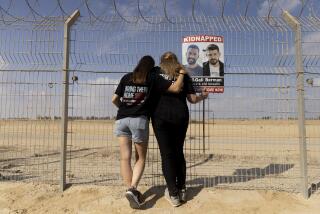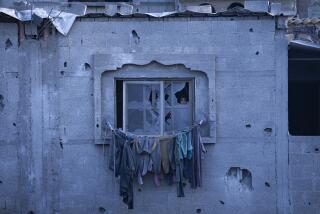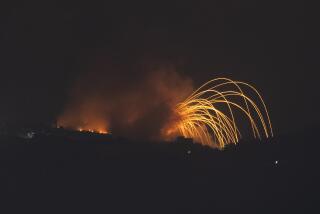COLUMN ONE : A Flawless Strategy for Victory : The U.S.-led coalition’s careful military planning and effective economic sanctions against Iraq turned the ‘mother of all battles’ into an allied rout.
- Share via
WASHINGTON — Iraqi dictator Saddam Hussein warned that it would be the “mother of all battles.” Instead, it has become the “mother of all surrenders.”
After months of allied concern over Iraq’s battle-hardened million-man army, thousands of tanks and artillery pieces, chemical weapons and fearsome defenses, the attack against Iraqi forces by the 28-country U.N. coalition appears to have turned into a full-fledged rout.
As of Tuesday night, more than 30,000 Iraqi troops had surrendered--virtually without incident--to U.S. and other coalition forces, some even trying to give themselves up to small teams of journalists who were advancing on Kuwait city.
What happened to enable the allied forces to achieve what appears to be such a sweeping victory?
Experts and military commanders cite these developments:
* Although Iraq had amassed huge numbers of tanks and artillery, they apparently were inadequate to compensate for Baghdad’s glaring deficiency in aircraft, electronic warfare gear and other high-tech weaponry, which left Iraq without a complete weapons system with which to fight.
* Shortcomings in Baghdad’s war machine made the Iraqi army a hapless victim of its own vulnerabilities, seemingly enabling the allies to turn many of Iraq’s initial strengths into major weaknesses.
For example, although Baghdad had erected elaborate fortifications, they eventually became a prison for immobilized Iraqi combat vehicles, making them more vulnerable than ever to allied air attacks, experts said. Hussein’s insistence that his army rely heavily on orders from central command became a formula for chaos when allied warplanes destroyed Iraqi communications centers. And Iraq virtually squandered its million-man army by sending raw recruits to lead the defense in this past week’s ground war.
* The Iraqis also apparently fell this week for a massive, months-long allied deception that caused them to abandon their Western flank in southern Iraq, while bracing for an allied assault only into Kuwait. The ploy allowed the coalition forces to waltz virtually unimpeded into the bleak, rocky terrain of southern Iraq when the massive pre-dawn ground assault began Sunday.
* Then, Iraqi soldiers, drained by weeks of bombing and psychological warfare, seem to have concluded that they could not handle allied ground forces with the easy brutality of their initial invasion of Kuwait.
The result of all of these factors has been what Anthony Cordesman, a Georgetown University professor and an expert on the Iran-Iraq War of the 1980s, calls a “catalytic collapse.”
Although Cordesman contends that “no one could have predicted the shock impact of what happened to the Iraqis,” he argues that “there’s no great mystery here.”
Cordesman says “a vastly superior force in tactics, professionalism, training and equipment met a force that totally lacked initiative, had no way to recover itself and in every tactical area proved inferior.”
James F. Dunnigan, author of “How to Make War,” a primer on modern warfare, agrees that the key to the allies’ success was their vastly superior resources.
“Victory almost always goes to the bigger battalions,” Dunnigan says. “To put it another way, victory is a property of the wealthy. Battles may be won by a David, but the Goliaths win the wars.”
In reality, however, the allied campaign has involved not just the last three days of ground fighting, but more than 6 1/2 months of what Gen. Colin L. Powell, chairman of the Joint Chiefs of Staff, outlined on Feb. 7 as a seamless, unfolding plan of assaults from all quarters--”a single, integrated campaign.”
The attack began early in August with more than six months of economic sanctions that deprived Iraq’s war machine of the supplies and parts that it needed to maintain and equip its army.
Then came five weeks of furious allied air assaults, designed to wipe out Iraqi air defenses and pummel artillery and ground installations.
To Powell and other military commanders, the results of those preliminary campaigns--and the signs of the Iraqi military’s brittleness--were becoming clearly visible in early February.
Allied warplanes had achieved unchallenged control of the skies and chased the “flower of the Iraqi air force”--its MIG-25 fighters and F-1 Mirages--into Iran.
Unmolested, the allied warplanes were improving their ability to attack Iraq’s dug-in military equipment, and the air war was on its way to claiming 100 Iraqi tanks--and at least as many artillery pieces and armored personnel carriers--per day.
By mid-February, Pentagon officials said, the Iraqi military appeared increasingly hollowed out. On Feb. 19--five days before the ground war began--Gen. H. Norman Schwarzkopf, commander of U.S. forces, declared that the Iraqi military was “on the verge of collapse.”
The gradual but steady collapse of the Iraqi capability was intentionally shrouded by the Administration. For months, U.S. officials went to Capitol Hill to argue that sanctions and aerial bombardment themselves would not succeed in pushing Iraqi troops from Kuwait.
But their remonstrances belied the heavy impact that the sanctions--and later the air war--were having, particularly on the Iraqi military, which was deprived of food and necessary maintenance supplies, according to captured Iraqi soldiers.
By October, the sanctions had begun to deplete Iraq’s supplies of tires and lubricants--both vital supplies for its military machine.
By late January, less than two weeks after the air war had begun, the allies had sharply reduced Baghdad’s ability to resupply its southern troops--by 90% in some cases. In many areas, such necessities virtually disappeared.
The combined effect of the sanctions and the bombardment forced the Iraqis to hold their tanks and armored vehicles unoiled and undriven in their berms and trenches, setting them up to rust until many were virtually useless as fighting machines.
Pentagon officials believe that by the time allied forces crossed the border into Iraq and Kuwait, a major part of Iraq’s estimated 4,200 tanks had been destroyed by bombardment or immobilized by lack of maintenance.
“Most of them can’t move,” said a knowledgeable Pentagon planner the day the ground assault began. The soldiers inside, he added, were faced with only two choices: “They’re going to either surrender or die in place.”
The ferocity of the air war itself--and toll that it took on the Iraqi army--all but guaranteed that the Iraqi military would crumble under the further pressure of ground assaults, U.S. officials said.
Eighteen days into the air war, a senior Pentagon official said the U.S. expected allied warplanes to destroy 50% of the Iraqi military’s combat vehicles before recommending that a ground war be launched.
On Feb. 24, when the ground war actually began, at least 38% of Iraq’s tanks and 48% of its artillery pieces--the only measure in which the Iraqis had clear numerical superiority--had been put out of action.
But even such levels of destruction were more than the allies needed to force Iraqi units to the breaking point.
During the eight-year Iran-Iraq War, Iraq’s Republican Guard routinely retreated from battle when only 20% to 30% of its combat power had been destroyed. And ordinary infantry units would seldom fight beyond the point at which 40% of their capability was gone.
But the relentless allied bombardment not only destroyed Iraq’s equipment, it also produced a devastating psychological impact that destroyed the Iraqis’ will to fight.
The return of the allied bombers night after night was a stark reminder to Iraqi troops that they had been left without air cover, without supply lines and unable even to get out of their trenches to bury their dead.
In the end, however, Bush Administration officials say, it was Hussein himself who delivered the final blow to his troops--by launching a flurry of diplomatic maneuverings in the weeks before the ground war was launched. Those initiatives further demoralized his troops.
Hussein’s sudden peace bid on Feb. 15 marked “a very significant break in their will to fight,” one senior Pentagon official said. “It’s going to collapse their morale--they’re in effect being told they’re not fighting for anything any more.”
For most Iraqi units, that crushing blow would come after front-line soldiers had been kept off-balance by a week of ground-shaking aerial bombardment, artillery shelling, “reconnaissance-in-force” missions and probing maneuvers.
The coalition forces’ apparently successful, repeated preinvasion ruses began as soon as the VII Army Corps arrived in the Arabian desert in mid-December from its headquarters in Germany. The corps concentrated its maneuvers south of Kuwait, then moved its thousands of tanks and tens of thousands of troops to the Iraqi border just 10 days before the ground assault commenced, feinting a direct, straight-ahead attack.
There were also feigned charges by the 1st Calvary Division in northern Saudi Arabia against Iraqi troops deployed in southern Kuwait.
U.S. forces for weeks before the ground assault had lobbed round after round of rockets and artillery and staged helicopter raids at the junction where Iraq, Kuwait and Saudi Arabia meet; to the undiscerning enemy, this appeared as if the allies hoped to soften up the Iraqis for a major attack at that point. But the U.S.-led coalition’s main thrust actually occurred about 100 miles away.
On Sunday, as thousands of allied troops sped across the border, the allies launched even more feints, designed to lead Iraqi commanders and their troops to believe that an overwhelming force was attacking them from all sides.
Military commanders in the field say the ploys worked, citing the dearth of Iraqi tanks or troops they encountered once the land war began.
Advancing allied troops found that the Iraqi minefields were far less extensive than had been feared and that many of the explosives had already been exposed. Iraqi shelters were flimsy and long ago had been abandoned by soldiers who had been redeployed far to the east, apparently in anticipation of an allied invasion of Kuwait.
In some cases, the defensive positions were little more than slit trenches that zigzagged across the fine sand, with little more than sandbags for reinforcement.
“There was absolutely nothing there,” said 1st Lt. Tom Mather, an Apache helicopter pilot with the 24th Infantry Division.
At his daily briefing in Riyadh, Marine Brig. Gen. Richard I. Neal of the U.S. Central Command observed of the feints, “I think it was superb prior planning, to tell you the truth.”
And for Iraqi troops, the crushing force of the allies may have proven to be the final demonstration that they had been abandoned, a U.S. official said.
“Saddam Hussein has betrayed his army,” a senior Pentagon official said Tuesday. “He has led them into a blind alley. He is leading them to their destruction. Armies don’t fight for leaders like that.”
Healy reported from Washington and Chen reported from Dhahran, Saudi Arabia.
More to Read
Sign up for Essential California
The most important California stories and recommendations in your inbox every morning.
You may occasionally receive promotional content from the Los Angeles Times.











